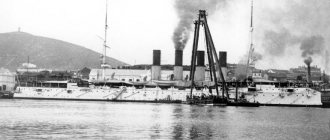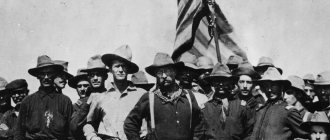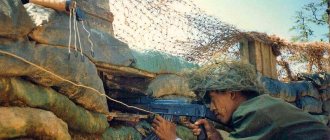See the text for the photos here:
110 years since the start of the defense of Port Arthur
Telegrams from the fronts of the Russian-Japanese War - January-February 1904
Telegrams from the fronts of the Russo-Japanese War - March 1904
Telegrams from the fronts of the Russo-Japanese War - April 1904
Telegrams from the fronts of the Russo-Japanese War - May 1904
Telegrams from the fronts of the Russo-Japanese War - June 1904
Telegrams from the fronts of the Russo-Japanese War - July 1904
Telegrams from the fronts of the Russo-Japanese War - August 1904
Telegrams from the fronts of the Russo-Japanese War - September 1904
Telegrams from the fronts of the Russo-Japanese War - October 1904
Telegrams from the fronts of the Russo-Japanese War - November 1904
Telegrams from the fronts of the Russo-Japanese War - December 1904
Telegrams from the fronts of the Russo-Japanese War - January 1905
Telegrams from the fronts of the Russo-Japanese War - February 1905
Telegrams from the fronts of the Russian-Japanese War - March-April 1905
Telegrams from the fronts of the Russo-Japanese War - May 1905
Telegrams from the fronts of the Russo-Japanese War - June 1905
Telegrams from the fronts of the Russo-Japanese War - July 1905
Telegrams from the fronts of the Russo-Japanese War - August 1905
Russo-Japanese War 1904-1905 Port Arthur - Russian squadron. Russian fleet in Port Arthur.
Russo-Japanese War 1904-1905 Port Arthur - Russian squadron. Return of the squadron to the internal roadstead.
Russo-Japanese War 1904-1905 Port Arthur - Russian squadron. Adjutant General Alekseev monitors the progress of the squadron's maneuvers
Russo-Japanese War 1904-1905 Port Arthur - Russian squadron. Squadron battleship "Retvizan".
Russo-Japanese War 1904-1905 Port Arthur - Russian squadron. Commander of the battleship "Retvizan" captain 1st rank Shchensnovich
Russo-Japanese War 1904-1905 Port Arthur - Russian squadron. Squadron battleship 1st rank "Retvizan".
Russian squadron battleship "Retvisan" - characteristics:
Built in the USA, Philadelphia, in 1902 (American project).
Dimensions: 117.8 m x 22 m x 7.9 m
Maximum speed - 18.8 knots
Armament: four 305 mm guns, twelve 152 mm guns, twenty 11-pounder guns
Displacement - 12,702 tons.
Russo-Japanese War 1904-1905 Port Arthur - Russian squadron. Squadron battleship of the 1st rank "Tsesarevich".
Russo-Japanese War 1904-1905 Port Arthur - Russian squadron A group of officers and technicians of the battleship "Tsesarevich" after its repair in Port Arthur
Russo-Japanese War 1904-1905 Port Arthur squadron. Sailors-miners of the battleship "Tsesarevich"
Russian squadron battleship "Tsessarevitch" - characteristics:
Built in Toulon, France in 1903 (French design)
Dimensions: 118.5 m x 23.2 m x 7.9 m
Maximum speed - 18.5 knots
Armament: four 305 mm guns, twelve 152 mm guns, twenty 3-pounder guns
Reservation - 178-254 mm sides, 254 mm main caliber turret, 152 mm auxiliary caliber turret
Displacement - 13,122 tons.
Russo-Japanese War 1904-1905 Port Arthur - Russian squadron. Cruiser 1st rank "Pallada" and its commander Captain 1st Rank Kossovich
Russo-Japanese War 1904-1905 Port Arthur - Russian squadron. Cruiser I rank "Pallada" (exactly the same type as the cruiser "Diana"). Built in St. Petersburg on Galerny Island in 1899 and cost about 6 million rubles. Length - 406 feet, beam - 55 feet, displacement - 7,270 tons. It does not have side armor on the sides, but only deck armor. The team is about 700 lower ranks and 32 officers.
Russo-Japanese War 1904-1905 Port Arthur - Russian squadron. Squadron battleship "Peresvet"
Russo-Japanese War 1904-1905 Port Arthur - Russian squadron. Russian battleship "Peresvet"
Russo-Japanese War 1904-1905 Port Arthur - Russian squadron. Squadron battleship "Peresvet"
Russian squadron battleship "Peresvet" - characteristics:
Built in St. Petersburg at the Baltic Shipyard in 1901
Dimensions: 130 m x 21.8 m x 7.9 m
Maximum speed - 18.6 knots
Armament: four 254 mm guns, eleven 152 mm guns, twenty 75 mm guns, twenty 47 mm guns, eight 37 mm guns, 5 torpedo tubes
Displacement - 12,674 tons.
Russo-Japanese War 1904-1905 Port Arthur - Russian squadron. Launching of the new squadron battleship Pobeda at the Baltic Shipyard.
Russo-Japanese War 1904-1905 Port Arthur - Russian squadron. The squadron battleship Pobeda, which was hit by a mine in the middle of the starboard side on March 31 during the restructuring of the squadron (in Port Arthur).
Russo-Japanese War 1904-1905 Port Arthur - Russian squadron. Squadron battleship "Pobeda" and its commander, captain 1st rank Zatsarenny 1st
Russian squadron battleship "Pobeda" - characteristics:
Built in St. Petersburg at the Baltic Shipyard in 1900
Dimensions: 133 m x 21.7 m x 8.3 m
Maximum speed - 18.5 knots
Armament: four 254 mm guns, eleven 152 mm guns, twenty 76 mm guns
Displacement - 12,872 tons.
Russo-Japanese War 1904-1905 Port Arthur - Russian squadron. The destroyer "Steregushchy", which famously fought near Port Arthur
Russo-Japanese War 1904-1905 Port Arthur - Russian squadron. Lieutenant A.S. Sergeev, commander of the destroyer Steregushchy, which participated and died in the battle of Port Arthur
Russo-Japanese War 1904-1905 Port Arthur - Russian squadron. The destroyer "Steregushchy", which died in the battle near Port Arthur.
Russo-Japanese War 1904-1905 Port Arthur - Russian squadron. The launch of the new Russian cruiser Askold at the Germany shipyard in Kiel. Celebration of the consecration of the cruiser.
Russo-Japanese War 1904-1905 Port Arthur - Russian squadron. Cruiser I rank "Askold".
Russo-Japanese War 1904-1905 Port Arthur - Russian squadron. Cruiser I rank "Askold".
Russo-Japanese War 1904-1905 People of war. Officers of the cruiser "Askold"
Russian cruiser "Askold" - characteristics:
Built in Kiel, Germany in 1900 (German design)
Dimensions: 133.2 m x 15 m x 6.2 m
Maximum speed - 23.8 knots
Armament: twelve 152 mm guns, twelve 76 mm guns
Displacement - 6,198 tons.
Russo-Japanese War 1904-1905 Port Arthur - Russian squadron. The new Russian cruiser Novik, built and launched in Elbing, at the Schichau shipyard.
Russo-Japanese War 1904-1905 Port Arthur - Russian squadron. The 2nd rank cruiser Novik, which became famous in the battle of Port Arthur.
Russo-Japanese War 1904-1905 Port Arthur - Russian squadron. Commander of the 2nd rank cruiser Novik, captain 2nd rank N.O. von Essen.
Russo-Japanese War 1904-1905 Port Arthur - Russian squadron. Cruiser II rank "Novik". Built in Elbing (Germany) in 1901 and cost more than 3 million rubles. Length - 360 feet, beam - 40 feet, displacement - 3,080 tons. Extraordinary speed - 25 knots per hour. Team - 325 lower ranks and 15 officers.
Russo-Japanese War 1904-1905 Port Arthur - Russian squadron. 2nd rank cruiser "Boyarin"
Russo-Japanese War 1904-1905 Port Arthur - Russian squadron. Russian cruiser "Boyarin"
Russian cruiser "Boyarin" - characteristics:
Built in Denmark, in 1901
Dimensions: 105 m x 12.65 m x 4.88 m
Maximum speed - 22.5 knots
Armament: six 120 mm guns, eight 47 mm guns, one 37 mm gun, 5 torpedo tubes
Displacement - 3,200 tons.
Russo-Japanese War 1904-1905 Port Arthur - Russian squadron. The 1st rank cruiser "Varyag", which died off the coast of Chemulpo, in Korea, after a heroic battle with a powerful enemy who unexpectedly attacked it.
Russo-Japanese War 1904-1905 Port Arthur - Russian squadron. Cruiser 1st rank "Varyag" and its commander, captain 1st rank Rudnev.
Russian cruiser "Variag" - characteristics:
Built in Philadelphia, USA in 1900 (American design)
Dimensions: 129.5 m x 15.8 m x 6.3 m
Maximum speed - 23 knots
Armament: twelve 152 mm guns
Displacement - 6,604 tons.
Russo-Japanese War 1904-1905 Port Arthur - Russian squadron. The seaworthy gunboat "Korean", which perished off the coast of Chemulpo, in Korea, after a heroic battle with an overwhelmingly powerful enemy that unexpectedly attacked it.
Russo-Japanese War 1904-1905 Port Arthur - Russian squadron. The gunboat "Korean", which took part in the bombardment of the Chinese fortress of Taku (photo taken in 1900).
Russo-Japanese War 1904-1905 Port Arthur - Russian squadron. The gunboat "Koreets" and its commander, Captain 2nd Rank Belyaev 2nd.
Russian gunboat "Korietz" - characteristics:
Built in Stockholm, Sweden in 1886
Dimensions: 66.7 m x 10.6 m x 3.7 m
Maximum speed - 12.5 knots
Armament: two 228 mm guns, one 152 mm gun, etc.
Displacement - 1,290 tons.
Russo-Japanese War 1904-1905 Port Arthur - Russian squadron. The gunboat "Beaver", which took part in the bombardment of the Chinese fortress of Taku (photographed in 1900).
Russo-Japanese War 1904-1905 Port Arthur - Russian squadron. The seaworthy gunboat "Brave", which took part in repelling and destroying Japanese fire ships trying to block the entrance to Port Arthur harbor.
Russo-Japanese War 1904-1905 Port Arthur - Russian squadron. The seaworthy gunboat "Rattling", which took part in repelling and destroying Japanese fire ships trying to block the entrance to Port Arthur harbor.
Russo-Japanese War 1904-1905 Port Arthur - Russian squadron. Squadron battleship 1st rank "Poltava". Built in St. Petersburg (in the New Admiralty) in 1894 and cost more than 8 million rubles. Length - 369 feet, beam - 70 feet, displacement - 10,960 tons. The team is about 800 lower ranks and 35 officers.
Russo-Japanese War 1904-1905 Port Arthur - Russian squadron. The squadron battleship "Petropavlovsk", which was lost in an explosion on the roadstead of Port Arthur. Built in 1894 in St. Petersburg, length - 369 feet, width - 70 feet, displacement 10,960 tons, speed - 16.86 knots. Armament - 57 guns, of which 4 large 12-inch caliber and 12 six-inch, the latest model; in addition - 6 mine vehicles. The cost of the battleship is about 8 million rubles
Russo-Japanese War 1904-1905 Port Arthur - Russian squadron. Battleship "Petropavlovsk"
Russo-Japanese War 1904-1905 Port Arthur - Russian squadron. Officers and crew of the battleship "Petropavlovsk" (photo from 1903) click on photo to enlarge
Russo-Japanese War 1904-1905 Port Arthur - Russian squadron.
Vice Admiral S.O. Makarov, who died in the explosion of the battleship Petropavlovsk.
The great Russian artist V.V. Vereshchagin, who died on the battleship Petropavlovsk
Russo-Japanese War 1904-1905 Port Arthur - Russian squadron. Descent of the Russian cruiser "Bayan" in Toulon (1900).
Russo-Japanese War 1904-1905 Port Arthur - Russian squadron. 6-inch long-range 35-caliber gun on a cruiser.
Russo-Japanese War 1904-1905 Port Arthur - Russian squadron. Cruiser "Bayan"
Russian cruiser "Bayan" - characteristics:
Built in Toulon, France in 1900 (French design)
Dimensions: 135 m x 17 m x 6.7 m
Armament: two 203 mm guns, eight 152 mm guns
Reservations - 203 mm belt, 76 mm bow and stern, 178 mm turret
Displacement - 7,924 tons.
Note: due to a design problem with the supply of coal from the bunker to the firebox, the cruiser could not maintain high speed for a long time
Russo-Japanese War 1904-1905 Port Arthur - Russian squadron. 1st rank cruiser "Diana"
Russo-Japanese War 1904-1905 Port Arthur - Russian squadron. 1st rank cruiser "Diana"
Russian cruiser "Diana" - characteristics:
Built in St. Petersburg in 1902
Dimensions: 123 m x 16.8 m x 6.4 m
Armament: eight 152 mm guns, twenty-four 75 mm guns, eight 37 mm guns, 3 torpedo tubes
Displacement - 6,731 tons, speed - 20 knots
Russo-Japanese War 1904-1905 Port Arthur - Russian squadron. Destroyer "Lieutenant Burakov".
Russo-Japanese War 1904-1905 Port Arthur - Russian squadron. Commander of the destroyer "Lieutenant Burakov", Lieutenant S.S. Dolgoborodov.
Russo-Japanese War 1904-1905 Port Arthur - Russian squadron. The destroyer "Resolute" and its commander Lieutenant Roshchakovsky.
Russo-Japanese War 1904-1905 Port Arthur - Russian squadron. The crew of the destroyer "Resolute" in Chifo Mogila D.M. Volovich, killed in Chifoo by the Japanese on the destroyer "Resolute" Midshipman of the destroyer "Resolute" S.M. Petrov
Russo-Japanese War 1904-1905 Port Arthur - Russian squadron. Destroyers of the Russian fleet
Russo-Japanese War 1904-1905 Port Arthur - Russian squadron. Mine explosion
Russo-Japanese War 1904-1905 Port Arthur - Russian squadron. Squadron battleship "Sevastopol".
Russian battleship "Sevastopol" - characteristics:
Built in St. Petersburg in 1895
Dimensions: 112.5 m x 21.3 m x 8.6 m
Armament: four 305 mm guns, twelve 152 mm guns, twelve 47 mm guns, twenty-eight 37 mm guns, 6 torpedo tubes, 50 barrage mines
Displacement - 11,800 tons, speed - 15.3 knots
“Captured – according to knightly rules”
– How did the surrender take place?
– After the decision to surrender is made, a civilized surrender of the fortress occurs. The Japanese allowed the officers to keep their weapons, the officers were allowed to go home on their word of honor not to fight Japan, Emperor Nicholas II allowed them to be given. Some of the officers went home, some went into captivity, not wanting to abandon their soldiers. Moreover, the Japanese did not take the wounded prisoners; they sent them all home. Everything happened according to European, then still somewhat knightly, rules.
– If we touch on the overall human losses in the war...
– The losses for Japan were, if not colossal, then very significant. Port Arthur is just one of the theaters, and there was also Manchuria with major battles. First of all, Mukden. The fact is that Japan fought the war on debt. Her resources and finances were depleted, she urgently needed peace, otherwise she would simply crumble financially. No one then hid the fact that they fought with American and British money. But, unfortunately, Port Arthur and Tsushima fall and a revolution begins. All these defeats in the political sense did not give us the opportunity to continue the war and required an urgent conclusion of peace. Tsushima could have been avoided, and we didn’t want to, the squadron was heading to Vladivostok, but the Japanese forced a battle on us, which ended so unhappily, which was the last straw in our bad luck in this war.
Returning to Port Arthur, I would like to note that it was truly a genuine example of heroism. The fact alone that during the entire defense there were no voluntary surrenders with weapons testifies to this. Of course, this war played a big negative role in the fate of Russia, it pushed for revolution, and its significance for us is very great. We went from being in a mood of mischief to disappointment. Russian society responded vividly; according to tradition, they collected large amounts of charitable assistance for the army through the Red Cross Society. Well, opposition circles from the very beginning wanted defeat for their own country. Someone even sent congratulations to the Japanese emperor on his victory. There were other bad examples... And it’s interesting that the policy article by V.I. Lenin’s title was precisely “The Fall of Port Arthur”: he did not choose the entire war, but precisely this example, believing that the “fall” of the entire state system in Russia began with it...








